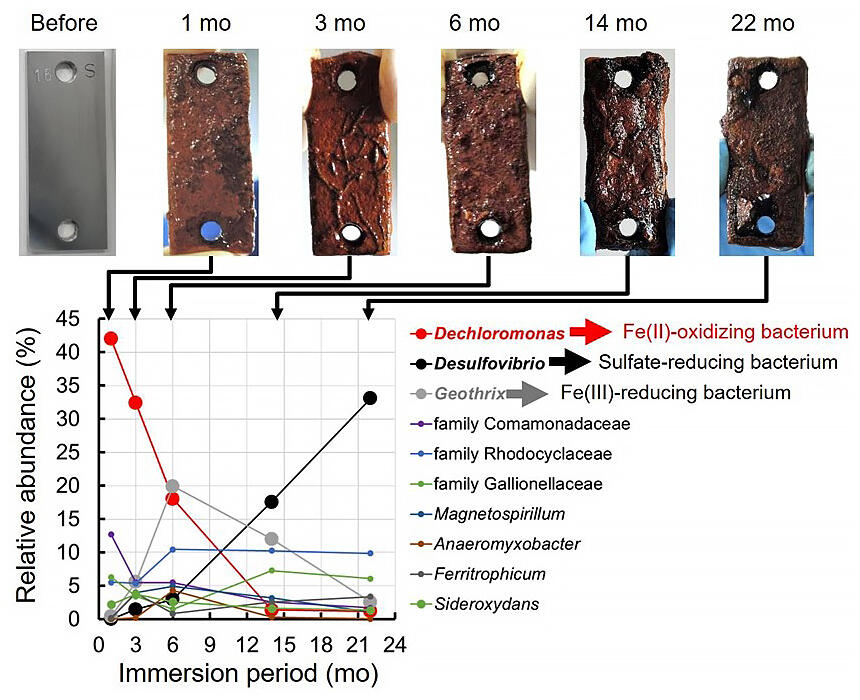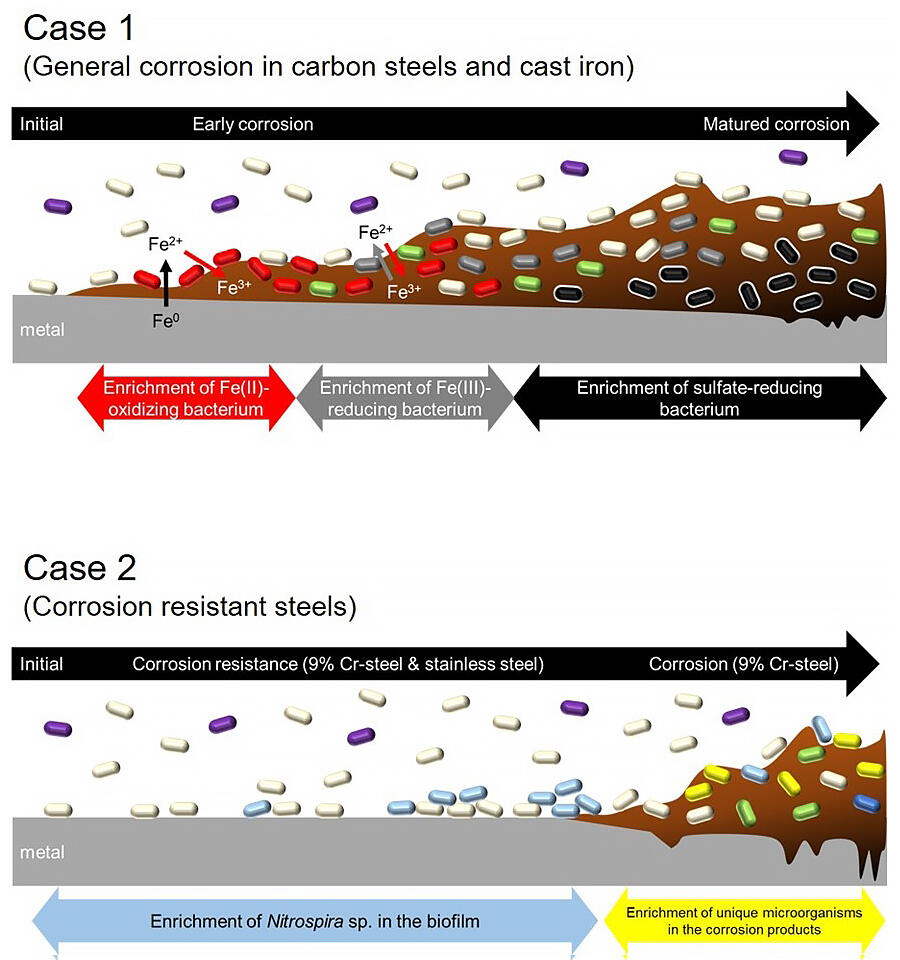A research group consisting of Dr. Satoshi Wakai, a researcher of the Institute for Extra-cutting-edge Science and Technology Avant-garde Research (X-star), the Japan Agency for Marine-Earth Science and Technology (JAMSTEC), Associate Professor Yasuyuki Miyano of the Department of Systems Design Engineering, the Graduate School of Engineering Science, Akita University and their colleagues has succeeded in clarifying that the microbes involved in the process of metal corrosion undergo remarkable change.
Research on the phenomenon of metal corrosion caused by microbes (microbial corrosion) has been carried out for over 100 years, but until now no-one has developed an effective diagnostic technique for this. In the past, researchers have proposed a model that involved sulfate-reducing bacteria, and this was widely accepted, but the dynamics within the corrosion process hadn't been clarified. Thus, the research group immersed multiple types of metals in an environment in which microbial corrosion manifests for 22 months, and investigated the state of the corrosion and changes in microbe groups.
More specifically, the group immersed nine metals in a facility that handles industrial water from a freshwater environment and withdrew them two sets at a time after 1, 3, 6, 14, and 22 months; the first set was used to calculate the corrosion level from the weight loss, and the second for microbial analysis of the biofilm (slime) on the surface of the metal and the rust (corrosion product). For the microbial analysis, the group engaged in analysis of the microbial community structure, investigating what kind of microbes were present and to what extent, by extracting DNA from the collected biofilms and rust and analyzing their gene sequences.

Provided by JAMSTEC
The results made it clear that during the early process of corrosion, sulfate-reducing bacteria were barely present and there was a high ratio of iron-oxidizing bacteria in the microbe groups, but as the corrosion advanced this decreased and instead the ratio of iron-reducing bacteria increased - the ratio of sulfate-reducing bacteria also increased as the corrosion progressed. Moreover, the group confirmed that when an alloy had a high chrome content, there was a remarkable increase in microbes with a sulfur oxidation function.
During this research, when the group investigated changes in metal corrosion behavior and the structure of microbial communities over a long period of time, they were able to understand the dynamics of microbial corrosion in a real "black box" environment.

In the case of corrosion-prone metal materials, the microbial community changes as shown in the upper panel, and it is possible to evaluate the stage (early, middle, or late) of corrosion by surveying the microbial community structure at a certain timing. In the case of a corrosion-resistant material (lower panel), we also clarified the difference between the microbial community structures when the metal material is healthy and when corrosion occurs. Such information would contribute to understanding of the corrosion mechanisms of stainless steels, which are not well understood.
Provided by JAMSTEC
Dr. Satoshi Wakai commented, 'In recent years, the development of portable genetic testing devices has progressed, and I believe it is now possible to quickly and accurately diagnose microbial corrosion at the field level, where a variety of corrosion phenomena have become issues, by combining microbe information and portable devices. Currently, research is going ahead on microbial corrosion in marine environments, especially the deep sea, and I hope that the outcomes we obtain will be put to good use in the field of offshore resources development in Japanese coastal waters.'
■ Sulfate-reducing bacteria: Bacteria that uses sulfate ions to carry out energy metabolism instead of oxygen in respiration. This reduces sulfur to hydrogen sulfide. It has long been thought that these are the microorganisms that cause metal corrosion, because hydrogen sulfide is corrosive to metals.
■ Iron-oxidizing bacteria: Bacteria that acquires energy by oxidizing iron (II) (Fe2+).
■ Iron-reducing bacteria: Bacteria that uses iron (III) (Fe3+) to carry out energy metabolism instead of oxygen in respiration.
Journal Information
Publication: npj materials degradation
Title: Dynamics of microbial communities on the corrosion behavior of steel in freshwater environment
DOI: 10.1038/s41529-022-00254-0
This article has been translated by JST with permission from The Science News Ltd.(https://sci-news.co.jp/). Unauthorized reproduction of the article and photographs is prohibited.




